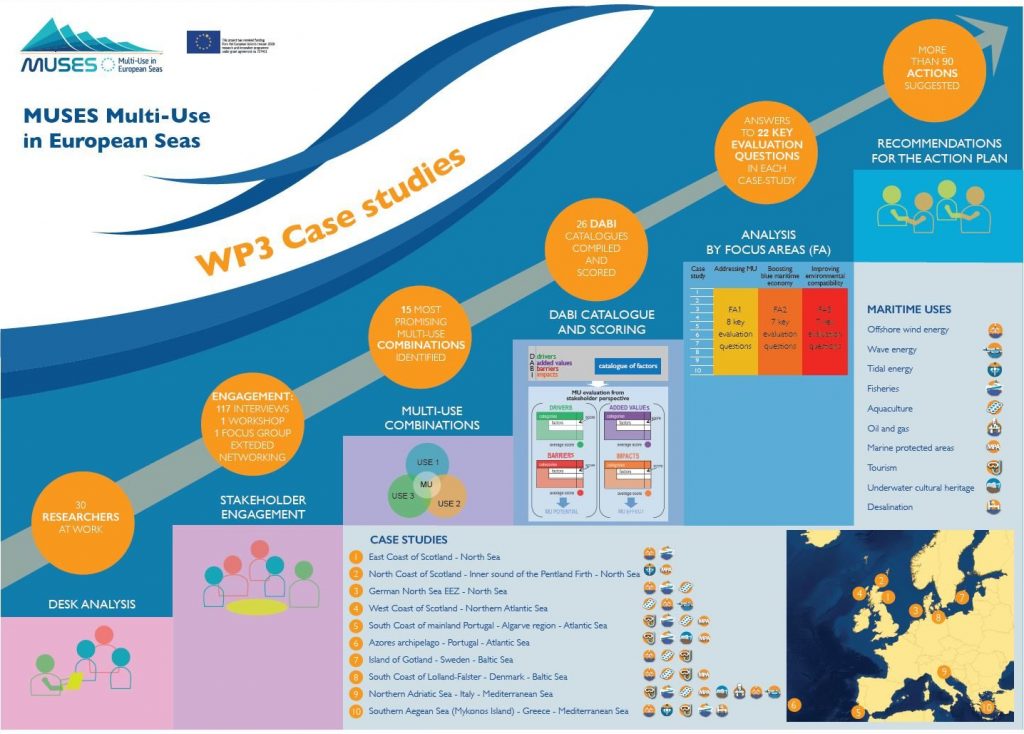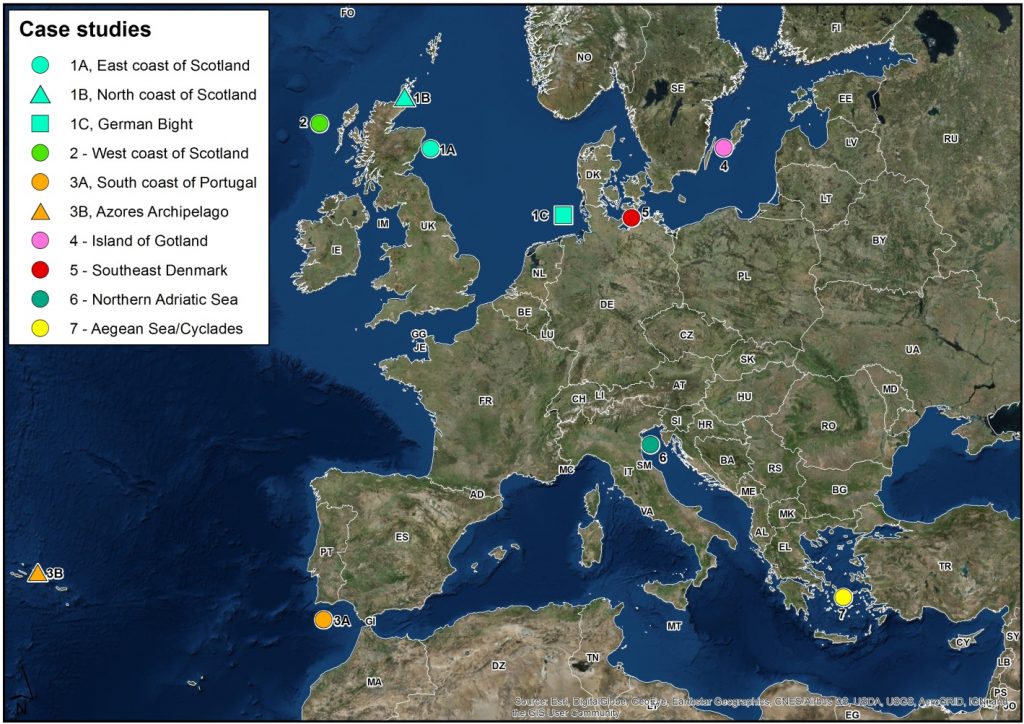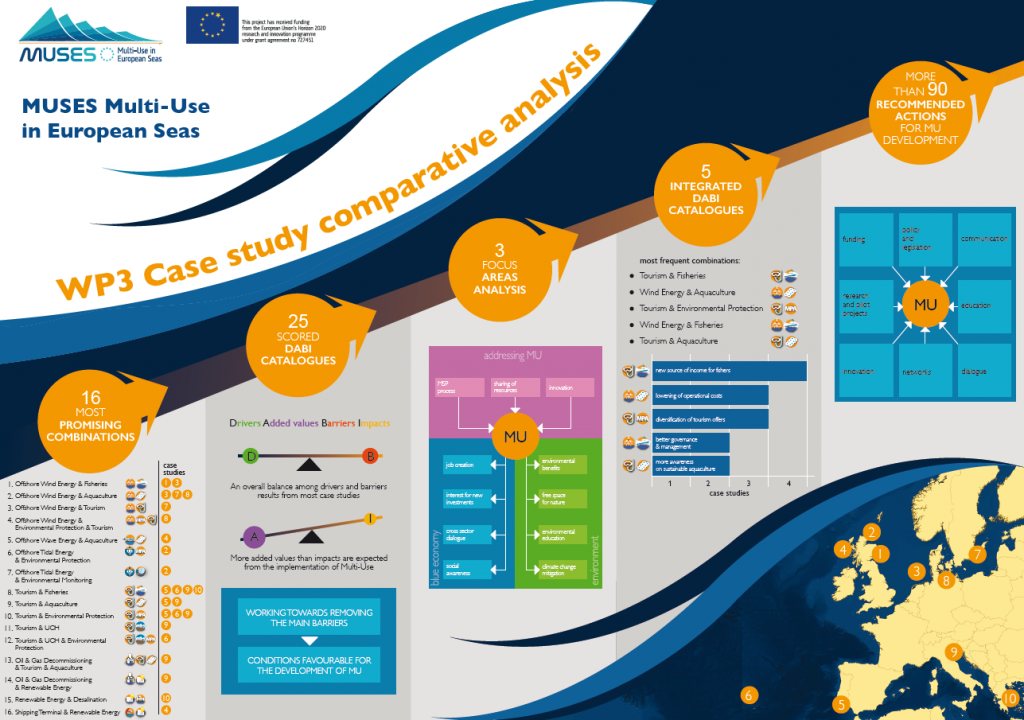MUSES considered potential synergies for multi-use, as well as the challenges encountered, through a series of 7 case studies with different thematic, geographic and focus area dimensions. Case studies undertook desk analysis and stakeholder engagement to identify barriers, opportunities, limitations and needs.
Case Studies Selection
The criteria for case studies selection was:
- geographical representativeness of European Seas concerning MU / coexistence experiences;
- off-shore and near-shore representativeness;
- coverage of different economic sectors of the Blue Growth Strategy;
- consideration of both “strong uses of the sea” by industrial and engineering sectors (e.g. off-shore platform and energy production) and “soft uses of the sea” (e.g. small-scale, artisanal fishery, aquaculture, tourism, etc.);
- representativeness of different levels of MSP process maturity;
- representativeness of both already implemented MU cases and examples of potential MU cases.
Case Studies
- Case Study 1: North Sea
- Case Study 2: North Atlantic Sea (West Coast of Scotland)
- Case Study 3: Southern Atlantic Sea
- Case Study 4: Baltic Sea (Swedish Waters)
- Case Study 5: Baltic Sea (Danish Waters)
- Case Study 6: Mediterranean Sea (Northern Adriatic Sea)
- Case Study 7: Mediterranean Sea (Agean Sea)
Case Study Objectives
- to provide a complete spectrum of advantages and limitations in combining different uses of the sea;
- to create local stakeholder platforms discussing (including beyond the project) MU potentiality, opportunities and limitations;
- to identify barriers and opportunities of MU of the marine space to be addressed by the Action Plan (WP4) and possible local actions, and;
- to concretely contribute to the advancement of MU in the context of each specific case study
Case Study Methods
- Desk activity of review and analysis;
- Stakeholder involvement
Case Studies Main Focus Areas
Case studies were evaluated according to common conceptual categories, defined as “Focus Areas”. The following three Focus Areas were considered:
-
- Focus Area 1 “Addressing MU”: this Focus Area analyses MUs development potentialities. It is applied both to cases where MUs of the sea are not developed yet and to cases where MUs are already in place, but actions are needed in order to fully exploit MU potential.
- Focus Area 2 “Boosting Blue Maritime Economy”: this Focus Area analyses those aspects of MUs strictly linked to the development of maritime economy. Main objectives here are: to highlight economic added-value of co-use of resources (infrastructures, services, personnel); to identify strategies reducing risks associated with economic development of combined uses; to promote local entrepreneurship and create context to favour job creation, broader social aspects and promote economic recovery.
- Focus Area 3 “Improving environmental compatibility”: this Focus Area analyses those aspects of MUs linked to the protection of the marine environment and/or minimization of existing impacts. Main objectives here are (different objectives may suit to different case studies): to identify solutions to concentrate marine activities in order to minimize the use of sea space; to identify positive and negative impacts of MU; to identify technical solutions to minimize environmental impacts; to identify win-win solutions triggering both socio-economic development and environmental protection (e.g. sustainable tourism and MPAs or small scale fishery/aquaculture and MPAs).
Outputs
Case study methodology
The purpose of this document is to establish a common methodology for the analysis of MU at case study level, within WP3. This methodology provides case study leaders with a common approach to examine practical experience related to MU in their local contexts. Aiming at maximizing the degree of commonality between the two scales of analysis considered in the MUSES project (Sea Basin scale and local scale), this methodology incorporates some of the elements defined in the Analytical Framework (Analysing Multi-Use in the European Sea Basins) developed under WP2.
The methodology described in this document is aimed at guiding the process of information and data gathering and stakeholder engagement, providing the needed degree of homogeneity to the cross-cutting analysis of the seven case studies considered by the project. The methodology should be interpreted as a flexible tool to be adapted in its details in order to meet the needs of the single case study. This can be downloaded here.
The infographic below visually demonstrates the case study methodology.

Case study stakeholder engagement
The purpose of this document is to describe stakeholder identification and engagement at case study level, within WP3. Actions planned by case study leaders in order to interact with stakeholders are detailed here for each local case study of the MUSES project.
This document complements the MUSES Case study methodology deliverable where the methodological approach to WP3 is given and case studies are described in detail, considering their geographical and thematic scope and expected results. However, in order to guarantee the understanding of stakeholder role within WP3, some synthetic elements concerning WP3 activities are also provided in this document. This can be downloaded here.
Case study implementation
These documents present the results of case study implementation carried out in the framework of WP3.
As defined in the MUSES project proposal, we considered seven case studies (illustrated in Figure 1):

- Case study 1A – Multi-use space between commercial fisheries and offshore wind farms in Scotland (East Coast of Scotland – North Sea)
- Case study 1B – Tidal energy development and environmental protection and monitoring (North Coast of Scotland – Inner sound of the Pentland Firth – North Sea)
- Case study 1C – Multi-use of off-shore wind farms with marine aquaculture and fisheries (German North Sea EEZ – North Sea)
- Case study 2 – Marine Renewables & Aquaculture Multi-use including the use of marine renewable energy near the point of generation (West Coast of Scotland – Northern Atlantic Sea)
- Case study 3A – Development of tourism and fishing in the Southern Atlantic Sea (South Coast of mainland Portugal – Algarve region – Atlantic Sea)
- Case study 3B – Development of tourism and fishing in the Southern Atlantic Sea (Azores archipelago – Eastern Atlantic Sea)
- Case study 4 – Multi-Use for local development focused on energy production, tourism and environment in Swedish waters (Island of Gotland – Baltic Sea)
- Case study 5 – Offshore wind and mariculture: potentials for multi-use and nutrient remediation in Rødsand 2 (South Coast of Lolland-Falster – Denmark – Baltic Sea)
- Case study 6 – Coastal & Maritime Tourism and O&G Decommissioning as drivers for potential Multi-use in the Northern Adriatic Sea (Italy – Mediterranean Sea)
- Case Study 7 – Marine Renewable Energy Sources & Desalination, Fishing & Tourism in the South Aegean: the case of Mykonos Island (Greece – Mediterranean Sea).
In addition to the case study reports (downloadable using the links above) a short introductory report is also available to download.
Comparative Analysis and Final Report
This document presents the results of the “Case study comparative analysis” carried out in the framework of the MUSES project’s WP3 and can be downloaded here: Comparative Analysis and Final Report. The infographic below provides a visual summary of the comparative analysis.

